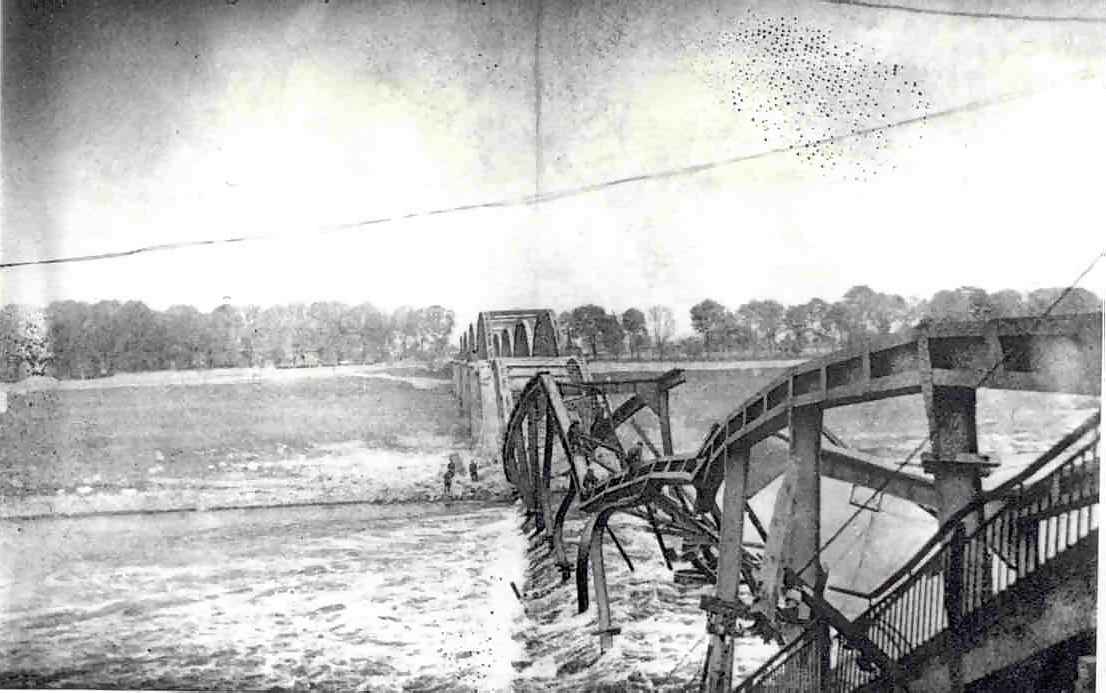
Figure: The Elbe River Bridge at Torgau on April 25, 1945, as it is being scaled
at 16:00 by the Robertson Patrol (American) and Andreyev Patrol (Soviet). The bridge was
destroyed by the Germans only hours ahead of the Allied advance on Torgau.
The handshake between the US Second Lieutenant Bill Robertson and the Soviet Sergeant Nikolai Andreyev on April 25, 1945, on the ruins of the bridge over the Elbe at Torgau, symbolized more than the Allies' victory over Nazi Germany in the Second World War. The meeting also meant the end of Torgau's existence as the hub of the German military penal system.
In 1939, two of the eight military prisons were in Torgau: Fort Zinna, built up between 1936 and 1939 into the German army's largest and most modern prison, and Brückenkopf. Both of the Torgau prisons housed prisoners convicted by German military courts, called "carriers of anti-military spirit": draft resisters, insubordinate soldiers, deserters, persons accused of "undermining military strength", "preferential treatment of the enemy", or "espionage", and soldiers convicted of criminal offenses. The inmates also included prisoners of war and members of the anti-Nazi resistance in Germany and the occupied European countries, as well as men from Luxembourg, Alsace and Lorraine who had resisted conscription into the German Army.
Torgau took on a key role in the German military justice system in March, 1941, when Army High Command (Oberkommando des Heeres, OKH) established the selection office for "probationary service" at Fort Zinna. Torgau's special function as an inspection and transfer station was further reinforced a year later when the High Command of the Armed Forces (Oberkommando der Wehrmacht, OKW) ordered the installation of Field Penal Camps I and II in Torgau.
Furthermore, in August, 1943, the Reichskriegsgericht, Germany's supreme military tribunal, was relocated to the Zieten Barracks in Torgau. Over the duration of the war, the highest court in the German military justice system issued nearly 1400 death sentences, of which some 1200 were carried out in Torgau and elsewhere. The victims included conscientious objectors—most of them Jehovah's Witnesses—members of the "Rote Kapelle" underground, French and Polish resistance fighters, American prisoners of war, and German generals.
The longer Germany's war dragged on, and the more hopeless it became, the more draconian the Nazi military courts became in fighting the flagging morale of the troops and the growing opposition to the war. More than a million German soldiers were convicted, and 20,000 were executed. By comparison, the Western Allies during the same period carried out some 300 death sentences issued by courts martial.
The exact number of executions carried out in Torgau can no longer be determined. The incomplete records of the army, the office of vital statistics and the cemetery administration show that at least 170 condemned soldiers were shot here. Other sources suggest, however, that the actual number of victims was significantly higher. Executions were carried out by firing squad in a gravel pit near the prison and in the moat on the north side of Fort Zinna.
After the war, few of the perpetrators were tried and sentenced. Most of the judges on the Reichskriegsgericht and other responsible military lawyers survived the end of the war unscathed, and continued their careers in the legal profession in West Germany.
Postscript
After the war, the Soviet secret police agency NKVD established its Special Camps Nos. 8 and 10 in Fort Zinna and in the nearby Seydlitz barracks. Germans and some Soviet citizens were interned here or served sentences passed by the Soviet military tribunals. The East German People's Police used the Fort Zinna prison from 1950 to 1990 as a penitentiary. In the 1950s it primarily housed political prisoners.
The Torgau Documentation and Information Center (DIZ), founded in 1991 and now under the administration of the Saxon Memorial Foundation for the commemoration of the victims of political despotism, researches and presents the history of the Torgau prisons in the permanent exhibition "Traces of Injustice".
Site support by Leader Technologies® — provider of Leader Phone® audio conferencing and teleconferencing services.